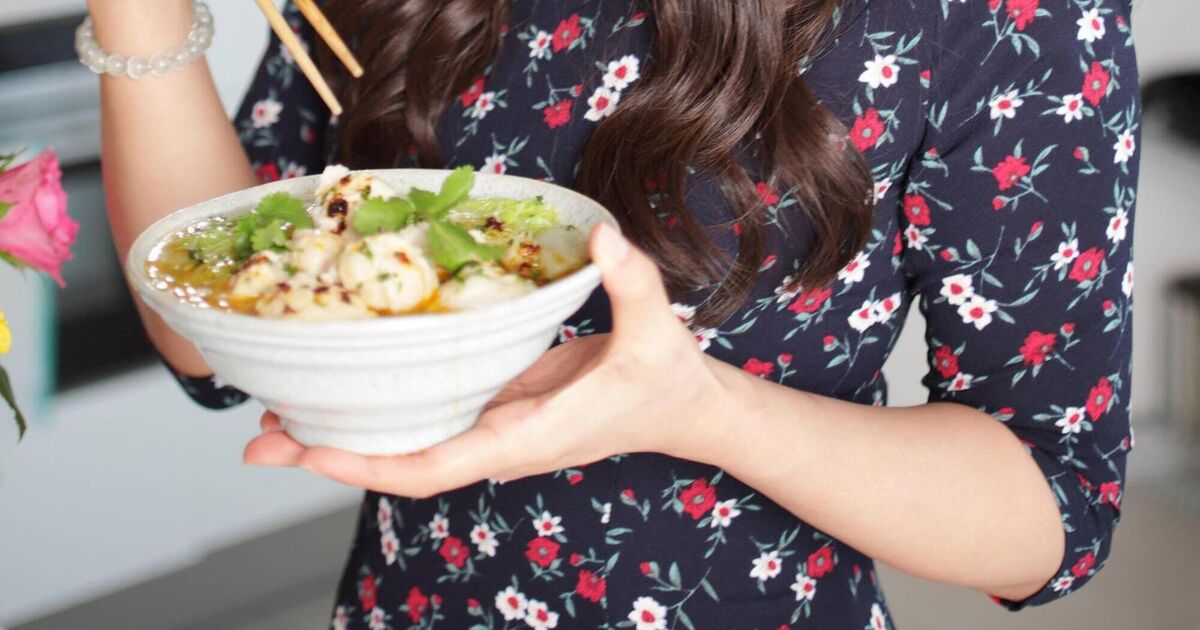THE cost-of-living crisis has forced most people to cut down their food budget. Taiwanese-born British chef Ching-He Huang first learned to cook on a shoestring when she was just 11.
------Advertisement-----
------Advertisement-----

------Advertisement-----

Wok For Less by Ching-He Huang is published by Kyle Books. Photography by Jamie Cho.

THIS dish is quicker than waiting for a takeaway.
In this dish, slivers of smoked bacon lardons are tossed with cucumber for a super umami-charged meal.
“You can use celery slices instead of cucumber to add a fresh, satisfying crunch,” says TV chef and cookery author Ching-He Huang.
“This punchy, spicy, tangy, sweet dish is perfect against the backdrop of plain jasmine rice. Once of my favourite combinations ever.”
1tbsp rapeseed oil
1 garlic clove, finely chopped
1 red chilli, deseeded and finely chopped
50g lean smoked bacon lardons, finely diced
1tsp Shaohsing rice wine large cucumber, deseeded and sliced into 0.5cm half-moons
¼tsp chilli bean sauce
1tbsp low-sodium light soy sauce
1tsp golden syrup
1tsp clear rice vinegar
6–8 roasted, unsalted peanuts
2 sprigs of fresh coriander, finely chopped
Very small pinch of dried chilli flakes
Cooked jasmine rice, to serve
- 1. Heat a wok over a high heat. Add the rapeseed oil and give it a swirl.
- 2. Add the garlic and red chilli, stirring for three to four seconds.
- 3. Add the smoked bacon lardons and stir-fry for five to 10 seconds until caramelised at the edges. Season with the Shaohsing rice wine.
- 4. Add the cucumber slices, chilli bean sauce, light soy sauce, golden syrup and clear rice vinegar, and toss well for 10 seconds until the cucumber has softened but still has a slight tender bite.
- 5. Add the roasted peanuts. Transfer to a serving plate, sprinkle over the coriander and dried chilli flakes and serve with jasmine rice.

THIS is a great dish for clearing the fridge.
“It’s amazing what a little carrot, red pepper and spring onion can do! Or you can use whatever veggies you have to hand – this one is delicious and versatile,” says TV chef and cookery author Ching-He Huang.
1tbsp rapeseed oil
1 garlic clove, peeled, crushed, and finely chopped
2.5cm piece of fresh root ginger, peeled and finely grated
1 red chilli, deseeded and finely chopped
½ red onion, sliced
100g smoked tofu, sliced into strips
1tsp dark soy sauce
1 carrot, trimmed and sliced into julienne strips on the diagonal
½ red pepper, cored, deseeded and sliced into strips
2 spring onions, trimmed and sliced into 5cm pieces
1tbsp Shaohsing rice wine
1tbsp vegetarian mushroom sauce
1tbsp low-sodium light soy sauce
1tsp golden syrup
1tsp toasted sesame oil
8 whole roasted, unsalted cashew nuts, halved
Cooked jasmine rice, to serve Black sesame seeds, to garnish
- 1. Heat a wok over a high heat until smoking. Add the rapeseed oil and give it a swirl.
- 2. Add the garlic, ginger, red chilli and red onion and toss for a few seconds.
- 3. Add the smoked tofu and season with the dark soy sauce, then toss for a few seconds. Add the carrot, red pepper and spring onions, then season with Shaohsing rice wine.
- 4. Add the vegetarian mushroom sauce, light soy sauce and golden syrup, and toss well.
- 5. Season with the toasted sesame oil, then add the roasted cashew nuts. Sprinkle over the black sesame seeds and serve with jasmine rice.

NOTHING beats a classic beef and oyster sauce broccoli chow mein.
“The combination of juicy beef rump steak tossed in an umami oyster sauce with tender broccoli steams on chunky egg noodles, and seasoned with big hits of ground black pepper makes this an all-round winner,” says TV chef and cookery author Ching-He Huang.
“Instead of the drier versions of this classic, I’ve made it saucier to coat the delicious noodles. Enjoy!”
For the beef:
180g beef rump fillet, diced
¼tsp bicarbonate of soda
2.5cm piece of fresh root ginger, peeled and finely grated
1tbsp oyster sauce
1tbsp low-sodium light soy sauce
2 pinches of ground white pepper
1tbsp cornflour
For the chow mein:
350ml water
200g long-stem broccoli, cut into bite-sized pieces
2tbsp rapeseed oil
200g cooked egg noodles
Pinch of ground black pepper
1 spring onion, trimmed and finely sliced, to garnish
For the seasoning:
2tbsp oyster sauce
1tbsp low-sodium light soy sauce
200ml cold vegetable stock 2tbsp cornflour
- 1. In a jug, add all the seasoning ingredients and stir to combine well.
- 2. In a bowl, add the beef pieces, bicarbonate of soda, ginger, oyster sauce, light soy sauce, ground white pepper and cornflour. Mix to coat well and let it marinate for 10 minutes.
- 3. Pour the measured water into a wok, then bring to the boil. Add the broccoli pieces and blanch for 30 seconds. Remove, then drain.
- 4. Reheat the wok over a high heat until smoking. Add the rapeseed oil and give it a swirl.
- 5. Add the marinated beef and let it settle for 30 seconds, then toss and stir-fry for five seconds to sear and colour the edges. For medium done, cook for another 20 seconds.
- 6. Add the sauce, bring to the boil and cook for three to four minutes until thickened enough to coat the beef.
- 7. Add the broccoli and cooked egg noodles. Toss together well, stirring everything thoroughly. Add the ground black pepper, sprinkle over the spring onion and serve immediately.
Vegan option: Add some chunky king trumpet mushrooms sliced into five centimetre batons, mushroom sauce instead of oyster sauce and wheat-flour noodles instead of egg noodles.
